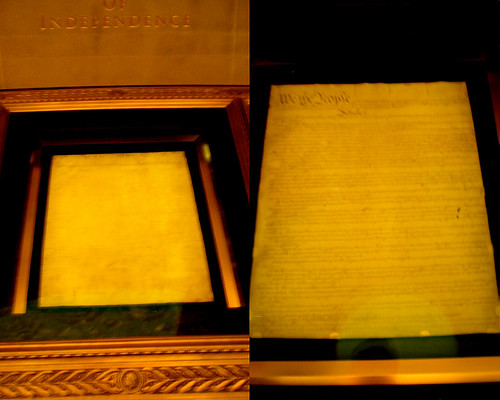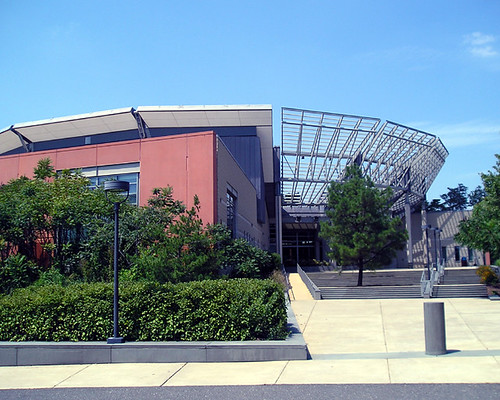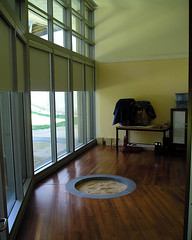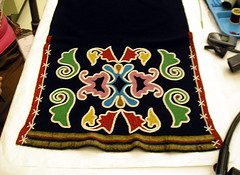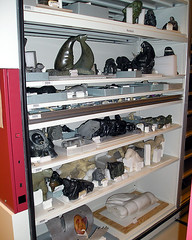Nearly fifty years ago, many in the country were asking whether or not John Kennedy could be trusted to be president of the United States because he was a Roman Catholic, and he might be subject to taking orders from the pope. This morning as I was sitting in St. Stephen's—a place where the Kennedy family often worshipped—I started thinking about that and the parallels of the current dilemma we have in the Republican Party with the upcoming 2008 presidential election.
What triggered this line of thinking is the fact that Friday night, we went to see the new movie
September Dawn, the true story of how the Mormons in Utah slaughtered a group of 120 Arkansas pioneers on their way to California in 1857, and the "conspiracy theory" that orders for the massacre came from the highest levels of the Mormon Church, even from then-president Brigham Young himself.
Now,
September Dawn purely as a movie wasn't really the best-made movie I've ever seen. Aside from some fine performances from Jon Voight as Bishop Samuelson and Terence Stamp as Brigham Young, the rest of the cast (mostly because of the script and direction) bounced between stilted and high school drama club. The movie was based on the few available details of the factual massacre, and the script writers took a great deal of artistic license to create a very predictable love story that dominated most of the movie, I guess to balance out the hard facts of church history, conspiring with the Indians, and killing men, women, and children. The editing is choppy, camera angles monotonous, and it was several minutes into the film and its jumping around from date to date that I finally figured out what was going on.
The one thing the movie did drive home, though, was the strong, controlling, dominating influence of religious fundamentalist fanasticism and what such zealots can do "in the name of God." Now, the Mormons certainly have no monopoly on fanaticism and murdering in the name of God. After all, the Catholics have been doing that for millennia (remember the Crusades? the Inquisition?), and the Protestants have continued it themselves for centuries (reformation wars, witch hunts, etc.). We're also seeing a lot of it these days with modern Muslims.
Fifty years ago, though, I would venture to say that most Catholics would be quick to question an order from the pope or some archbishop to go murder innocent people, and today in 2007, Catholics not only would question but would "tell them where to go." The papal control thing was never really a serious concern in 1960 with John Kennedy.
The Mormons, though, are completely another matter. Now, as a non-Mormon, I may not have all the details just right, but I think I understand the gist of things. I might also say that I have a number of friends and acquaintances who are Mormons, and I respect the family-centered commitment and uprightness of their church and membership, so I have no ax to grind against them. The Mormons have a president they believe is God's prophet on earth, and a high council of a dozen or so "apostles" they believe are also in direct communication with God. The Mormon Church is extremely hierarchical, with small, local groups being ruled by lay bishops who have pretty much absolute authority over the members of their wards. I know Mormons who have quit their jobs and moved to different towns to fulfill the orders of their bishop or higher church authorities, and others who have taken on volunteer positions or tasks even when they didn't really have time for them. Discipline and obedience are very highly prized standards in the Mormon Church. Certainly, they aren't the zealots they were in the mid-19th century and they don't go around killing their errant members anymore, but the rules and pressure for obedience are still there. And, thus, we have the source for the Republican's current dilemma: Mitt Romney.
If Governor Romney were to become President of the United States, if the highest councils of the Mormon Church were to tell him to do a particular thing, what would he do? Now, of course, Mr. Romney is going to say that he will fulfill his oath of office to the Constitution and to the People, and that will override anything the Mormon Church might want. Yet, what will really happen? I believe that even today, Mormons are acculturated to do what the church leadership tells them to do. If push comes to shove, my gut feeling is that Mr. Romney is going to do what his church tells him to do.
What is particularly interesting about the
September Dawn movie is Governor Romney's ancestor's role in the massacre. His Mormon polygamist great-great-grandfather "stole" an Arkansas woman to make her one of his wives, but the woman's husband didn't take kindly to that, and killed the Romney progenitor. It is believed that revenge and "blood atonement" for his death was one of the primary motivators for the Utah massacre of the Arkansans. I hear that Governor Romney does not plan to see
September Dawn.
There are many who are claiming that this movie was made solely for the purpose of embarrassing the Mormons and hindering Governor Romney's presidential campaign. I give that argument short shrift. The massacre is historical fact. Look at the date of the massacre, too: September 11, 1857. This is the sesquicentennial (a/k/a 150th anniversary) of the massacre. I hardly think that the Governor's detractors began planning this 150 years ago.
September Dawn isn't going to win any Academy Awards. It is a useful vehicle, though, to educate us about a sad chapter of American history and to remind us of the rules and traditions of a major religious organization in America. I don't believe the movie's purpose is to foment anti-Mormon sentiment or embarrass Romney any more than a movie about the 1507 historical incident when 30 "witches" were burned by the Spanish Inquisition would be anything more than a 500th anniversary observance of the event, and certainly not a movie attempting to drum up anti-Catholicism or embarrass the presidential campaign of Rudy Guiliani.
So, I take the movie on its face value. Release is pretty limited (it's only at one theater in all of Washington, D.C.!), so if its showing near you, consider seeing it, especially if you are unfamiliar with the Mormon Church. And, if you can't catch it this month, at least try to rent the DVD.
(By the way, the title of the post is a quote from the movie, when the Arkansans have been under siege and the Mormons show up to "help" them shortly before murdering all of them.)
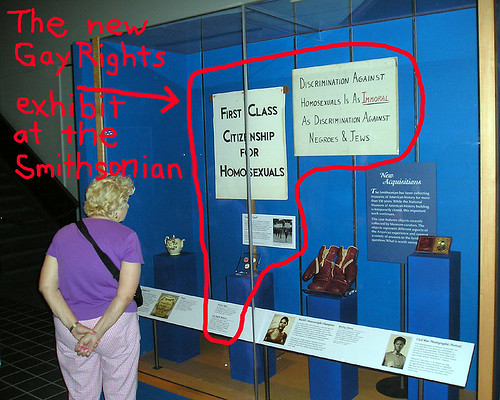
 In another part of the museum, I ran across what was marked as a panel in the AIDS Memorial Quilt. Unfortunately, the display did little to convey the enormous emotional impact—or purpose—of the Quilt. I don't know how many of you have ever seen portions of the quilt, but usually when I see it, panels are laid out in a way that entirely covers the floor of a gymnasium or convention center. Each panel was made by the family and friends of a victim of HIV, and offers a memorial to that person and his (or her) life and interests.
In another part of the museum, I ran across what was marked as a panel in the AIDS Memorial Quilt. Unfortunately, the display did little to convey the enormous emotional impact—or purpose—of the Quilt. I don't know how many of you have ever seen portions of the quilt, but usually when I see it, panels are laid out in a way that entirely covers the floor of a gymnasium or convention center. Each panel was made by the family and friends of a victim of HIV, and offers a memorial to that person and his (or her) life and interests.